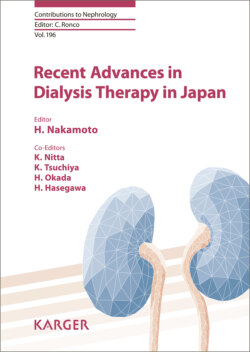Читать книгу Recent Advances in Dialysis Therapy in Japan - Группа авторов - Страница 33
На сайте Литреса книга снята с продажи.
Abstract
ОглавлениеBackground: Currently, left ventricular (LV) hypertrophy and dysfunction are considered the strongest predictors of cardiovascular mortality in chronic kidney disease (CKD) patients. We investigated the factors associated with elevated LV mass index (LVMI) using echocardiography and assessed the strategies used to treat CKD (stages 1–5D) patients. Summary: In study 1, we prospectively determined correlations among biochemical values, physical specimens, and LVMI using echocardiography in hemodialysis (HD) and peritoneal dialysis (PD) patients (stage 5D). In study 2, biochemical and physical values were collected over a period of more than 120 days prior to the initiation of dialysis in predialysis patients. LVMI was evaluated by echocardiography twice (at baseline and during follow-up at the initiation of the dialysis period). In study 3, physical, biochemical, and LVMI data were also retrospectively analyzed in 930 CKD (stages 1–5) patients. Results 1: In HD patients, LVMI values at 24 months were not significantly decreased compared with those at baseline. Systolic blood pressure (SBP) and hemoglobin (Hb) levels were identified as independent risk factors for LVMI after 24 months. In PD patients, LVMI values at 24 months were significantly decreased compared with those at baseline. Results 2: A lower LVMI at the initiation of dialysis and improved LVMI during the observation period were detected in the highest tertile of average Hb (10.4 g/dL). Results 3: In early CKD (stages 1–3) patients, LVMI, urinary protein, and Hb levels were independently associated with factors for progression to dialysis. In CKD (stages 1–5) patients, LVMI increased with decreasing renal function, and eccentric LV remodeling was increased. Levels of SBP and Hb were independent risk factors for LVMI. In the patients who showed worsening LVMI, the rates of change in SBP, proteinuria, and Hb were identified as independent risk factors for LVMI changes. Key Messages: It is important to treat hypertension and anemia to prevent LV remodeling not only during the dialysis stage but also from early CKD stages to initiation of dialysis in CKD patients. Our findings may offer potential therapeutic strategies for treating predialysis and dialysis patients.
© 2018 S. Karger AG, Basel
The incidence of end-stage kidney disease (ESKD) is steadily increasing worldwide. Cardiovascular disease is the main cause of morbidity and mortality in predialysis chronic kidney disease (CKD) patients [1]. Cardiovascular involvement in CKD patients primarily manifests as left ventricular (LV) hypertrophy (LVH) and LV dysfunction [2]. LVH is recognized as a potent risk factor for cardiovascular death in dialysis patients and is a strong predictor of myocardial infarction, cardiac failure, sudden death, and stroke [3]. Regression of LVH lowers the incidence of major cardiovascular events and improves survival rate [4]. Left atrial (LA) diameter defined by echocardiography is reported to be directly related to risk of cardiovascular death, and the association of LA enlargement with cardiovascular death appears to be partially related to LVH [5]. We aimed to investigate the factors associated with elevated LV mass index (LVMI) using echocardiography and to discuss the therapeutic strategies used to treat CKD (stages 1–5D) patients.
